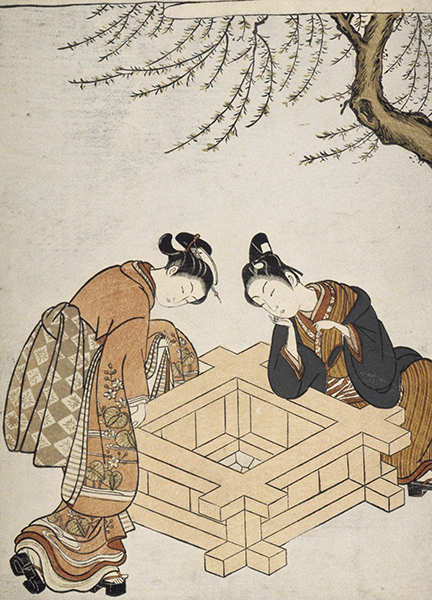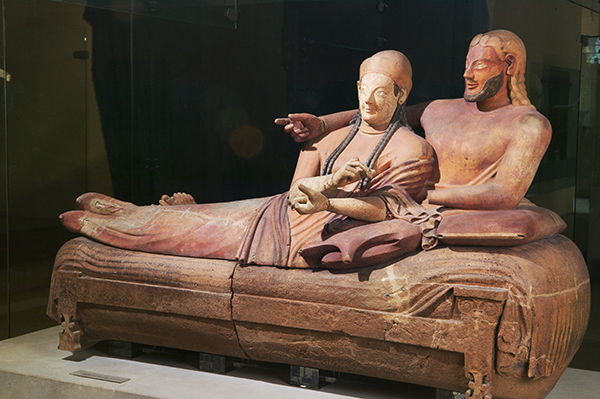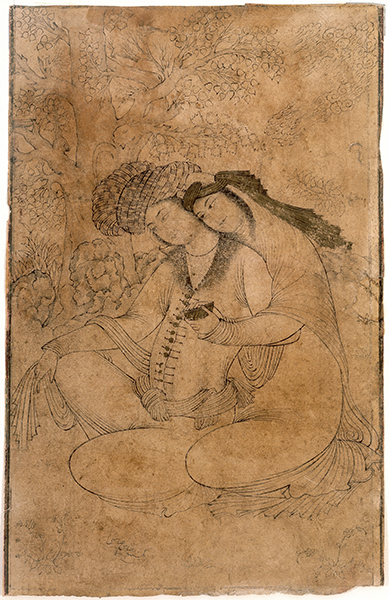Romance Awareness Month: Suzuki Harunobu, Etruria, Safavid
I was not aware of the association of romance with the month of August, but I think it’s refreshing. On one website that explains national month days, it said that “February isn’t the only month dedicated to romance. Jump start your romance in August!” I love that, and, as usual, I celebrate it with art.
 |
| Suzuki Harunobu (1725–1770, Japan), Lovers by the Well, ca. 1766. Color woodcut print on paper. Private Collection. © 2021 Davis Art Images. (8S-4160) |
Apparently, wishing wells exist around the world, not just in the West. I’m sure romance is similar around the world, too, and that couples wish at wells for success in love. In Japan, the custom is not to throw coins in, but to touch the lucky water of the well. Suzuki Harunobu did several prints on this subject.
A slightly birds-eye view is typical of Harunobu’s work, as are minimal background elements. Harunobu's prints are characterized by reed-thin, elegant figures composed of fluid contour lines. Like other ukiyo-e artists, he delighted in highlighting the most fashionable pattern combinations of the day. The woman in this print is distinguished from courtesans because her obi is tied in the back rather the front.
Male and female figures alike are treated with a feminine elegance and refinement in Harunobu's work. The male is distinguished in some prints by the sword handle protruding from his obi, and by the tonsure (shaved pate of his head) and top-knotted hairstyle as we see in this print.
Early ukiyo-e images were painted, but with demand high, artists turned to the woodblock medium. Initially these prints were black and white or three color. By 1764, the multiple block process (often as many as twelve for one print) was perfected, creating the nishiki-e (“brocade picture), so named for the wide range of colors available to the artist. Harunobu was one of the first artists to exploit the nishiki-e.
Little is known of Harunobu's life or art education. He is thought to have been born in Edo (Tokyo). It is also believed by scholars that he may have studied painting with the Kyoto ukiyo-e artist Nishikawa Sukenobu (1671–1750). Nishikawa was a pupil of Hishikawa Moronobu (1618–1694), considered one of the pioneers of the ukiyo-e style.
Harunobu's work was unremarkable early in his career, his prints following the conventions of the day that had been established by Moronobu. When he began using the multiple block technique in 1765 to illustrate a calendar for a poetry circle, the broader range of colors and more sophisticated print impressions made his work an instant sensation in Edo. The style he established epitomized what is considered the beginning of the "classical period" of the ukiyo-e genre.
 |
| Ancient Etruria, Sarcophagus of a Married Couple, from Cerveteri, ca. 530–510 BCE. Terra cotta, 44 7/8" x 6' 7" (114 x 200.7 cm). Musée du Louvre, Paris. Image © 2021 Dr Ron Wiedenhoeft/Saskia, Inc. (JIC-1082) |
What could be more romantic than committing your likeness to a sarcophagus with the one you love for eternity? Like many ancient cultures, funerary art played a significant role in the aesthetics of Etruscan culture. Common iconography for tombs was a sculpture of the deceased as part of the sarcophagus lid, a format that the Etruscans pioneered. This form evolved from the earlier custom of funerary urns topped with a lid featuring a portrait of the deceased. The intimacy and tenderness of these figures reflects more of the emotive quality of Hellenistic Greek sculpture rather than the strictly idealized, rational order of Classical Greek work.
Based on the features and drapery on this work, there is no mistaking that Etruscan art is grounded in Greek. The faces bear similarity to late Archaic Period (600–480 BCE) Greek sculpture bearing the so-called "archaic smile" of that period. However, unlike Greek sculpture, the Etruscan artists were not overtly interested in anatomical realism, as everything below the waist is generalized. Also, compared to the staid, stoic type of Greek funerary stelae, the affectionate embrace of the married couple is a graphic departure.
By the year 1000 BCE, northern Italy was occupied by people from central Europe known as the Villanovans. At the same time, various different cultures speaking similar Italic languages, including Latin, occupied central Italy. From the 600s BCE, the Etruscans, possibly related to the Villanovans, occupied most of northern and central Italy in a territory known as Etruria.
Although the Greek historian Herodotus (484–425 BCE) proposed that the Etruscans migrated from Lydia in Asia Minor in the 1200s BCE, many scholars believe the culture was native to the peninsula of Italy. They occupied the region of present-day Tuscany, from the Arno River in Florence to the Tiber in Rome. Etruria consisted of twelve major cities, each with its own king. The culture flourished between the 700s and 400s BCE.
The Etruscans traded with Carthage and the Greek colonies in southern Italy. From the Greeks, they absorbed artistic influences, first from works of the Archaic Period. Because of political and commercial troubles, Etruscans artists did not borrow again from Greek art until the 300s BCE. By this time, Etruscan power waned considerably after the Romans sacked their major city, close neighbor and bitter enemy, Veii (396 BCE). The culture was virtually swallowed up by the Romans after they defeated the last ruling kings of the Volsinii in 264 BCE.
 |
| Iran, A Pair of Lovers, 1600s (?). Ink or watercolor and gold-colored paint on paper, page: 7 ¼" x 4 5/8" (18.41 x 11.74 cm). © 2021 Albright-Knox Art Gallery, Buffalo, NY. (AK-825) |
Western Renaissance art greatly influenced Iranian art during the Safavid dynasty (1501–1736) as European artists were invited to provide painting workshops at the court. This influence included subject matter such as the loves of the ancient gods. Another influence on individual painting during the Safavid period was the abundant stories from classic Persian poetry and histories about "great loves." The subject of amorous courtly lovers became quite common in single leaf paintings, although it was frowned upon by the religious-minded.
This loving couple—most likely an unfinished painting—is typical of the court style of the Safavid rulers. The elongated bodies are elegantly curvilinear in design, defined totally by the slender, fluid contour line that varies little in thickness. Parallel groups of lines define headdress and garments, while features are generalized in much the same way as Chinese and Japanese art.
There may be some Western influence in the background tree, which, unlike in book illustration, is in the proper proportion to the seated couple. This idealization of courtly elegance had a great impact on Indian Mughal Period (1526–1857) depictions of the figure.
In Iran, the tradition of calligraphy and book decoration was perhaps the most well-established art form, having begun in the 600s CE with copies the Qur'an in beautiful scripts embellished with gold. The Safavids had flourished in their native Azerbaijan since the 1300s. When the Timurid dynasty declined during the 1400s, the Safavids gradually gained land and power in much of Iran.
The Safavids captured Tabriz from the Turks in 1501. This is the beginning of the Safavid Dynasty. The Safavids established Shia as the state religion of Iran. The economy of Iran flourished under the Safavids because of Iran’s position between burgeoning kingdoms in Europe and India and China in the east. The Silk Road ran through northern Iran at the time.
Under the Safavid rulers, art, architecture, and literature flourished. The Safavids were great patrons of the arts. Bookarts in particular thrived during the 1500s. Because of contact with European traders, the influence of European illuminated manuscript greatly impacted the Iranian art form. Safavid book illustration eventually influenced that of Ottoman (Turk) and Mughal (India).
The reign of Shah Abbas I (1571–1629, ruled 1588–1629) in Iran is considered one of the greatest periods in the Safavid dynasty. Book painting became less important in Iran toward the beginning of the 1600s. Single-page works of art became increasingly popular because lavishly illustrated books tended to be extremely expensive. Album pages, however, continued to follow the format and style of book illustration.


Comments